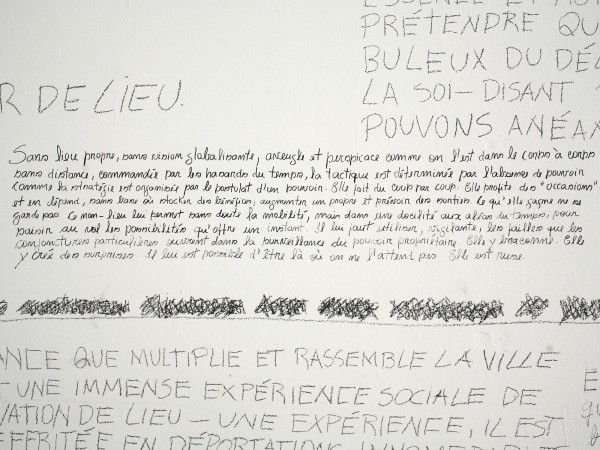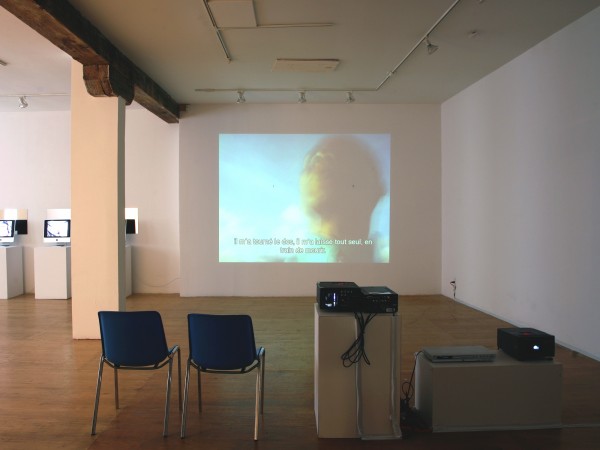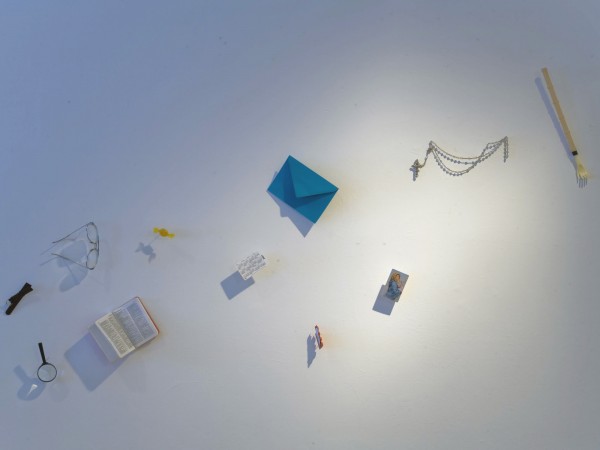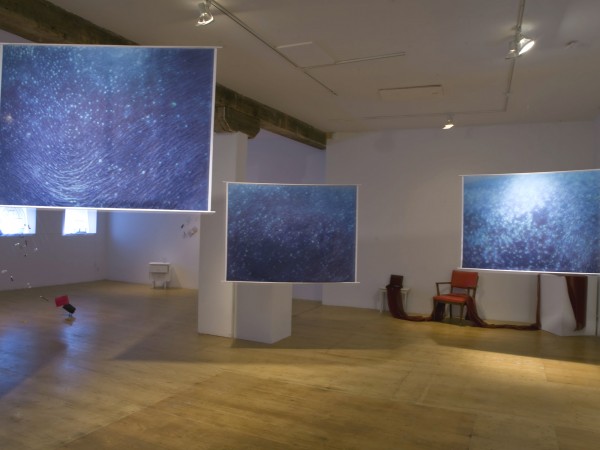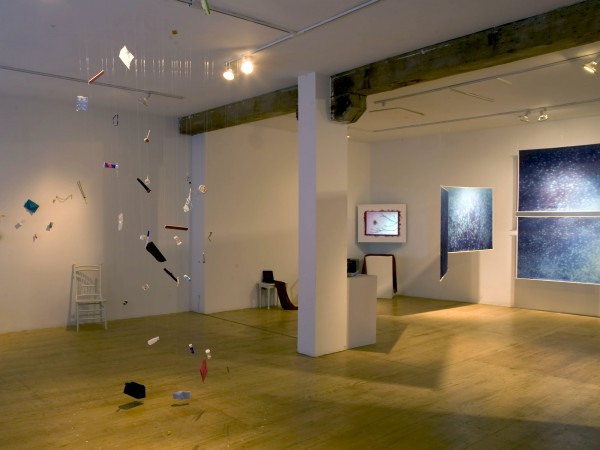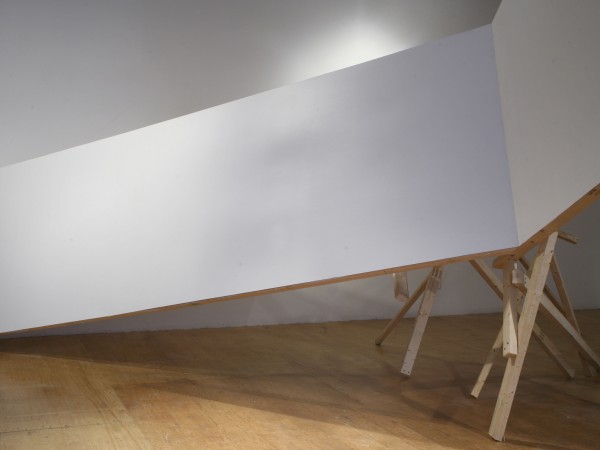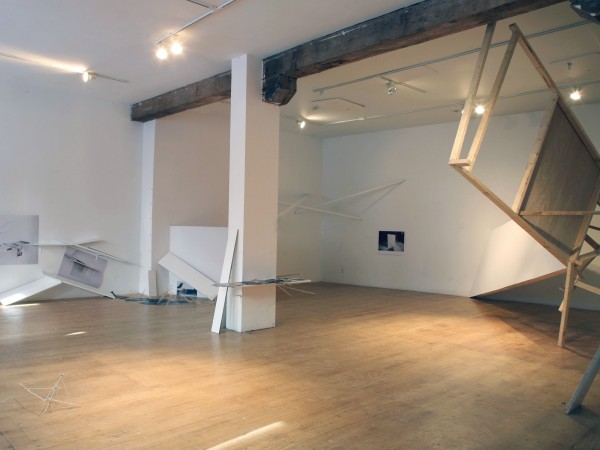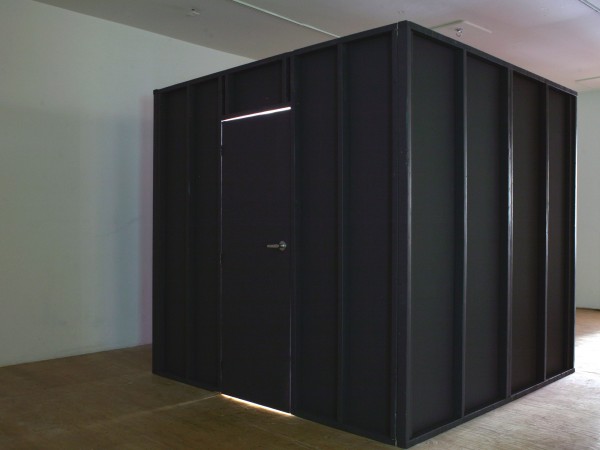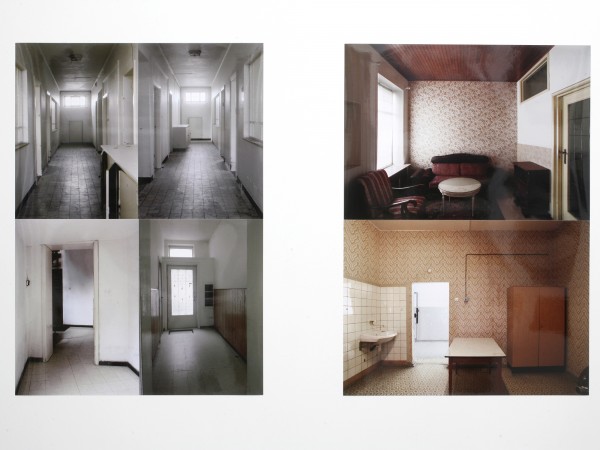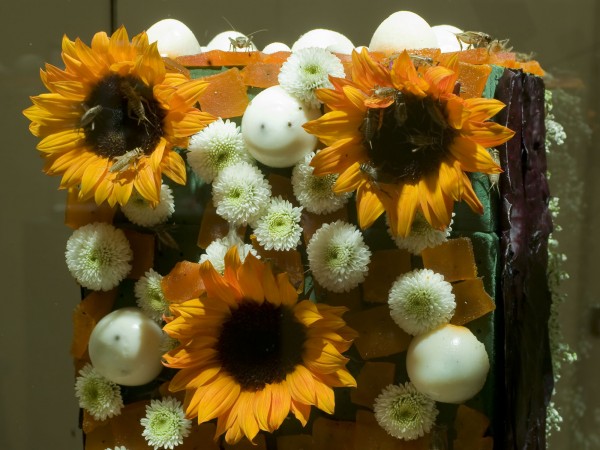
crédit photo: Ivan Binet
He rests,
before winding his tiny watch.
Is it finished, broken ? He rests a little more,
returns home and closes the door.
And so time slips away, as he turns the key in the watch’s delicate mechanism.
– Jules Renard – Histoires naturelles1
In the depths of winter, the first thing that we hear upon entering Adaime Makac’s installation at LA CHAMBRE BLANCHE is the sound of crickets. A pair of stools is positioned either end of six vivaria, in a game of mirroring. The receptacles house a ‘sculpture’ composed of a range of items that are planted in a bed of foam: flowers, fruit, and snacks. The scene evokes a Dutch still-life, with its mix of natural and artificial flowers. A forest of broccoli is sprinkled with pebble forms that reveal themselves to be rice balls. A carnival of fresh and dried tropical fruit offers up larger-than-life colors. As we look closer, we see that that each vivarium is inhabited by a colony of domestic crickets.
Adaime Makac’s Le Banquet lends a voice to these insects. She gives them center stage, as she has done with other animals in previous projects.2 The spectator is positioned in the role of voyeur, catching his/her reflection and the gaze of the other in the glass of the vivaria. Adaime Makac created a similar scenario in Observatoire (2007), an installation that took the form of a large table covered with mirrored tiles. Visitors were invited to sit at the table and observe the behavior of living mice, who made their way out from a small cube-shaped refuge at one end of the table. In this work, the mouse was a form of stand-in for the artist, the performer, the clever animal whose prowess we anticipate. In formal terms, the cube-shaped refuge that housed the rodents, which was also covered with mirrors, resembled the monolithic sculptures found in Le Banquet.
Le Banquet explored duration. It was as though the artist had created a situation, and then withdrawn leaving it to evolve, limiting herself to a few gestures of upkeep of the space, such as the selection of which detritus to conserve, and which elements to replace. In a manner of speaking the work ″makes itself,″ following its course in an almost-autonomous fashion, almost independently of the author/maker. In this respect/regard, the author Évelyne Toussaint speaks of, ″the artist who is content to lay out an arrangement of elements, setting the stage for improvisation.″3 Much time slips away before we see any ‘results’″4 remarks Adaime Makac, commenting on her video works. The artist, « seeks to accentuate a certain slowness and sense of repetition.″ The absence of spectacle is offset by the setting, whether the monoliths featured in Le Banquet, or the often-dramatic, color-saturated lighting that bathes the scenes she portrays in her video and photographic works. As the artist underlines, ″light acts as a costume.″

crédit photo: Ivan Binet
In Le Banquet, Adaime Makac once again chooses to work with insects, and more specifically orthopterans, having employed the shed skins of migratory locusts in Collection (Ready-dead) (2006), an installation presented at bbb in Toulouse. Spread out on a bed of black quartz, the cricket remains, which were collected on a beach in Libya, were embellished with sequins and adorned with makeup. This work prefigures Le Banquet, the title of a video installation created in 2005. The artist, working with live crickets this time, documented three stages of the destruction of a bouquet of flowers placed in a cage housing the insects. The staging of Le Banquet at LA CHAMBRE BLANCHE did not result in the production of video or photographic traces. Instead, a sequence of views of the vivaria at night was presented on a monitor placed in one of the gallery’s windows, offering an insight into the installation within, and arousing the curiosity of passers by.

crédit photo: Ivan Binet
Adaime Makac explains that the three-dimensional compositions placed in the vivaria are inspired by Sans titre (Structure qui mange) (1968) by the artist Giovanni Anselmo, who was associated with Italian Arte povera movement. In this work, granite monoliths combine with organic and perishable matter (such as lettuce) in a way that suggests that the material is being consumed, as the title suggests [in English: Untitled (Structure that Eats)]. Adaime Makac’s Le Banquet reverses this proposition, in offering structures for the crickets to eat; crickets that are, in a manner of speaking, actors in the installations in each of the six vivaria.
In society, insects are usually associated with the abject and with calamity, with few exceptions, butterflies for example. By and large however, insects are regarded as harmful, and therefore as undesirable. They destroy crops and infest houses. The extermination business is booming, barely managing to hide its play on our fears.
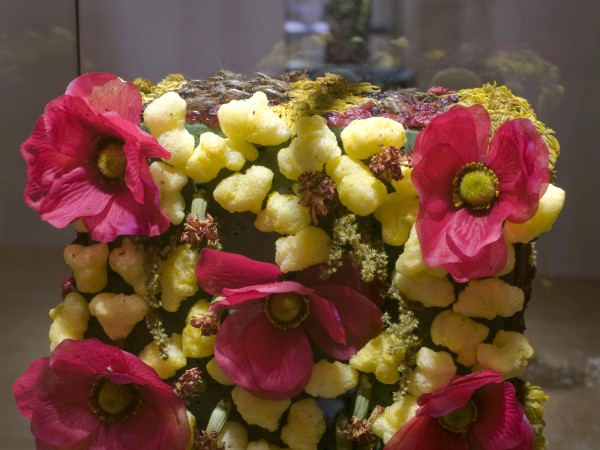
crédit photo: Ivan Binet
The Bible is perhaps at the root of man’s troubled relationship with insects. Amongst the famous plagues of Egypt cited in Exodus, and sent by Jehovah, targeting the Pharaoh who was holding the Israelites captive, three of the ten forms of pestilence involved insects, namely locusts, mosquitoes and horse flies. Given the exponential rate at which insects reproduce, a few specimens may result in an invasion. Rest assured, in Le Banquet, any overflow is contained ; the living processes take place on the inside of four sheets of glass.
Children are particular sensitive to all forms of animal life, and do not seem repulsed by insects. Occasionally, they even return home with their little discoveries, much to the disconcertment of their parents. Amongst adults, such a sensitivity appears out of the question, stifled even. It is as though, later in life, insects are only of interest to scientists. Adaime Makac’s installation introduces these creatures into the domain of art.

crédit photo: Ivan Binet
In pet shops, tarantulas, lizards and frogs are offered for sale….crickets also, though in the case of the latter, they are sold to feed others in the food chain. The space in which they are housed is usually rudimentary, with perhaps only a few empty egg boxes in an otherwise empty vivarium. In Le Banquet, Adaime Makac challenges this economy and celebrates the humble creature that is the cricket; she allows them to live, feast, copulate and die.
Insects in contemporary art
Artists have been putting insects ‘to work’ for several decades, introducing objects and materials into their environment, which the creatures ultimately transform.
I recently came across a work by the French artist Hubert Duprat, cited in a passage from a text in connection with the work of Adaime Makac.5 In a practice that encompasses a number of approaches, Duprat transforms the aquatic larvae of trichoptera or caddisflies into goldsmiths, equipping them with gold sequins and pearls, as well as precious and semi-precious stones, to create a protective nest that more usually would consist of twigs and grains of sand. The Canadian artist Aganetha Dyck places everyday objects in beehives, which the insects begin to coat in wax, creating cells.6 then removes the everyday items and uses them to create installations.7
However, in both these cases the artists appropriate the insects’ ‘productions’ and the creatures are ultimately absented from the work, leaving only their trace behind. In contrast, in Adaime Makac’s installation not only are they the principle actors, they are also the intrinsic content of the work, ‘what is to be seen’. The crickets live and die in the closed receptacle that is the installation. They are nourished by, and in turn alter, its form, leaving behind their waste and their skins.
Crickets in literature and music
Upon learning that Ivana Adaime Makac planned to work with crickets, a story by Charles Dickens, entitled The Cricket on the Hearth immediately came to mind: “[the cricket] has inspired numerous tales and stories. Once upon a time, it was considered to be a familiar, even a bringer of good fortune […].”8 Henry David Thoreau (1817-1862) frequently mentions crickets and their song in his diary, analyzing their behavior in detail. He salutes their seasonal return and marvels at the sounds they make as autumn advances. He observes them bore into mushrooms and apples, almost completely disappearing into the object that they are consuming. As an adolescent, I read Jules Renard’s Histoires naturelles, published in 1896. Later, I discovered that five of the stories he recounts – including that of Le Grillon [The Cricket] – had been put to music by Maurice Ravel. The cricket seemed to him “a fantastic creature, somewhere between the human and the machine, a creature with which the composer was perhaps the first to identify.”9
Despite the considerable difference of scale that separates us from crickets, we cannot help but feel empathy for them; we identify with their fragility. In the artist’s enlargements of video and photographic images of the insects, our sense of scale alters dramatically: under the color-saturated lighting, the creatures’ vital functions become dramatized, and aestheticized.
Ivana Adaime Makac’s Le Banquet creates a form of dynamic suspense, charged with meaning, somewhere between the abject and the delicious. A pleasure to the eye, her ephemeral sculptures elevate our gaze and propose a form of precarious beauty, aimed at transformation. The insects live and die at the bottom of the vivaria, moving around and going about their business, climbing the monoliths, and freely traversing the art that constitutes their habitat.
- Renard, Jules. 2010, Histoires naturelles. Paris: Presses universitaires de France, 91 p.
- I am thinking notably of Ivana Adaime Makac’s series of infra-red, silver-print photograpgs entitled Bestiaire (2004) that set insects against a backdrop of natural and artificial elements (flowers, stuff animals), and also of her video works Dormeur no. 1 (2005) and Limites No. 2 which, respectively, document the behavior of crickets and mice. The video installation Zophobas morios (2007) also comes to mind, featuring images of beetle larvae in movement.
- Toussaint, Évelyne. ″Les mondes éthologiques et esthétiques d’Ivana Adaime-Makac″. 2007, in ″ Flux-2: Parcours d’art contemporain en vallée du lot ″. Arles: Maison des arts Georges-Pompidou editions, p. 7.
- All citations of the artist’s comments are taken from an unpublished text (2008).
- Toussaint, Évelyne, art. cit.
- Fréchuret, Maurice, Roland Recht et Stephen Bann. 1998, Hubert Duprat. Antibes, Genève, Limoges: Musée Picasso editions, 132 p.
- See notably Madill, Shirley, Bruce Grenville, Joan Borsa, Sigrid Dahle et Gilles Hebert. 1995, Aganetha Dyck. Winnipeg: Winnipeg Art Gallery Editions, 64 p.
- Ivinec, Yann. 2006, ″The Cricket on the Hearth/Le grillon du foyer″. Traduit par Francis Ledoux. Paris: Gallimard, pp. 11-12. Ivinec’s preface makes a number of references to allusions to small insects from the orthoptera family in literature and music.
- Uwe Kraemer, from the program notes that accompany the recording Histoires naturelles by Ravel, with Gérard Souzay and Dalton Baldwin, released by the Philips record label. [Author’s translation].
Denis Lessard
